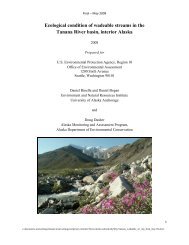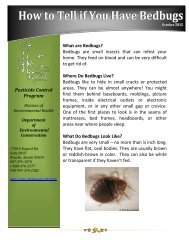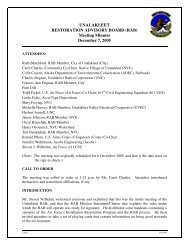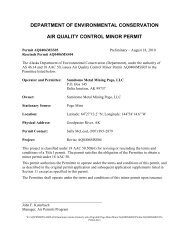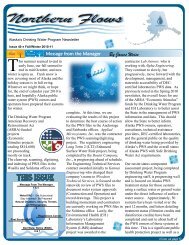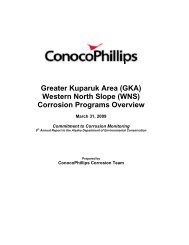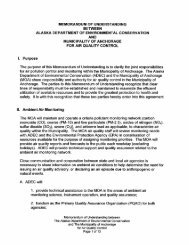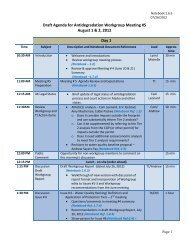2012 Ocean Ranger Guidebook Revision 3-7-12 - Alaska ...
2012 Ocean Ranger Guidebook Revision 3-7-12 - Alaska ...
2012 Ocean Ranger Guidebook Revision 3-7-12 - Alaska ...
You also want an ePaper? Increase the reach of your titles
YUMPU automatically turns print PDFs into web optimized ePapers that Google loves.
<strong>20<strong>12</strong></strong> <strong>Ocean</strong> <strong>Ranger</strong> <strong>Guidebook</strong> 3-7-<strong>12</strong><br />
than 6 knots 1 ; that graywater will not be discharged in port and will not be<br />
discharged within 4 nautical miles from shore or such other distance as agreed to<br />
with authorities having jurisdiction or provided for by local law except in an<br />
emergency, or where geographically limited. Member lines have further agreed that<br />
the discharge of graywater will comply with all applicable laws and regulations. For<br />
vessels whose itineraries are fully within US territorial waters, discharge shall<br />
comply fully with U.S. and individual state legislation and regulations.<br />
<strong>12</strong>. Blackwater: CLIA members have agreed that all blackwater will be processed<br />
through a Marine Sanitation Device (MSD), certified in accordance with U.S. or<br />
international regulations, prior to discharge. For ships traveling regularly on<br />
itineraries beyond territorial coastal waters, discharge will take place only when the<br />
ship is more than 4 miles from shore and when the ship is traveling at a speed of not<br />
less than 6 knots. 1 For vessels whose itineraries are fully within US territorial<br />
waters, discharge shall comply fully with U.S. and individual state legislation and<br />
regulations.<br />
Some member cruise lines are field-testing wastewater treatment systems that utilize<br />
advanced technologies. These onboard wastewater treatment systems, which are currently being<br />
referred to as advanced wastewater purification (AWP) systems, are designed to result in effluent<br />
discharges that are of a high quality and purity; for example, meeting or surpassing secondary and<br />
tertiary effluents and reclaimed water. Effluents meeting these high standards would not be<br />
subjected to the strict discharge limitations previously discussed.<br />
Each CLIA cruise vessel operator has agreed to utilize one or more of the practices and<br />
procedures contained in the attached “Cruise Industry Waste Management Practices and<br />
Procedures” in the management of their shipboard waste streams. Recognizing that technology<br />
is progressing at a rapid rate, any new equipment or management practices that are equivalent to<br />
or better than those described, and which are shown to meet or exceed international and federal<br />
environmental standards, will also be acceptable. Member lines have agreed to communicate to<br />
CLIA the use of equivalent or other acceptable practices and procedures. As appropriate, such<br />
practices and procedures shall be included as a revision to the attached document. As an<br />
example, when improved systems for treating blackwater and graywater are perfected and shown<br />
to meet the requirements for MSDs and accepted by appropriate authorities, the new systems and<br />
associated technology will be included in the attachment as a revision.<br />
CLIA and its Environmental Committee will continue to work with the U.S. Coast Guard,<br />
the U.S. Environmental Protection Agency and other appropriate agencies to further implement<br />
the above commitments.<br />
1 For vessels operating under sail, or a combination of sail and motor propulsion, the speed shall not be less<br />
than 4 knots.<br />
ATTACHMENT: CRUISE INDUSTRY WASTE MANAGEMENT PRACTICES AND PROCEDURES<br />
Revised: November <strong>12</strong>, 2006<br />
Effective for non-prior ICCL members: [July 1, 2007]<br />
149






